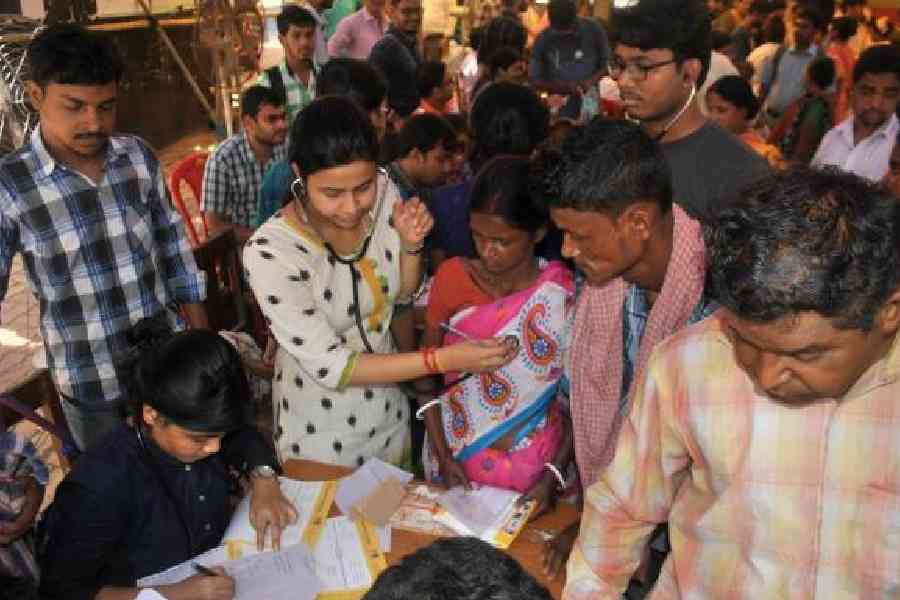Medicine Sans Frontiers


When trouble broke out in neighbouring Bangladesh in July, Indian students there started returning. The Union ministry of external affairs has since revealed that 8,500 students from India were in Bangladesh — a majority of them enrolled in an undergraduate medical degree.
According to Arindam Roy, who is executive director of foreign education consultancy EdXcare in Calcutta, Bangladesh attracts undergraduate medical students from India because tuition fees and living costs are less there. “It costs around Rs 25-30 lakh for the course, which is a fraction of the cost charged by some private medical colleges in India for management quota candidates.” In some private medical colleges in India, capitation fee for an MBBS course is around a crore.
That Indian students should go abroad to pursue an MBBS is nothing new. A combination of factors has incrementally made a seat in a medical college in India an elusive thing, but that’s another story. For our story here, suffice to say there was a time when the preferred destination was Russia, Ukraine, then China or some central Asian countries, but in the past two decades Bangladesh has emerged as a viable option. And from what those in the know have to say, a good option at that.
“There’s a misconception about the standard of medical education in Bangladesh,” says Dr Shubhankar Dixit, a surgeon in a government hospital in Kalyani. “The college I went to, Rangpur Medical College, is recognised by global medical statutory bodies such as the World Health Organization, General Medical Council (of the UK) and National Medical Commission (of India). The curriculum is extremely rigorous.” According to Dixit, students cannot bunk classes and there is equal weightage on theory and practice.
Bangladesh has 112 medical colleges with over 12,000 seats for undergraduate studies. Among these, 37 are run by the government, six by the Bangladeshi army and 69 are private colleges. In the top medical colleges, 25-40 per cent seats are earmarked for international students.
Dr Nilotpal Banerjee, a medical technologist at the All India Institute of Medical Sciences (AIIMS) in Kalyani, had worked in Bangladesh in an international medical technology company as an application scientist. He has had the experience of travelling across various medical institutions there. He tells The Telegraph that the MBBS course itself is similar in structure to such courses in Britain. For this reason, medical graduates from Bangladesh find it easy to find employment in the United Kingdom. Dr Banerjee adds, “The curriculum is quite rigorous in most government colleges and in some private institutions. And English is the medium of instruction.”
An undergraduate medical course in Bangladesh is of a duration of five years, followed by a year’s internship. This is unlike India where the yearlong internship now stands reduced to only six months.
As both India and Bangladesh are members of the South Asian Association for Regional Cooperation (Saarc), every year, 22 Indian students are granted full scholarships to study MBBS in top government medical colleges in Bangladesh.
Dr Dixit was a Saarc scholar of the 2009 batch. Such scholars are selected on the basis of merit by the Bangladeshi government. To be eligible for this opportunity, candidates must have achieved a more than good academic record or more than 98 per cent marks in Plus Two examinations. Approximately 1,400 aspirants apply for the Saarc medical scholarships every year.
A majority of students, however, join colleges without any scholarships. Passing India’s NEET exam is a requirement, but cut-off marks for admission are achievable, unlike in India.
Says Dr Dixit, “Most students from India are from Kashmir.” After the Russia-Ukraine war broke out, students from Kashmir started avoiding medical colleges there. It is also a fact that students who graduate from Russia and Ukraine don’t find it easy to practice in India. They have to, like every other student with a foreign medical degree, pass a screening test by India’s National Board of Examinations called the Foreign Medical Graduate Examination (FMGE). Only then are they allowed to practice here.
Medical colleges in Bangladesh are also ideal training grounds for students to gain experience in disciplines such as community medicine. Rookie doctors are exposed to thousands of patients with minimal access to sophisticated technology in the course of treatment. This helps them hone basic medical skills and learn patience and perseverance in a demanding situation.
“Students from Bangladesh clear FMGE rather easily, especially those who study in government colleges there,” says Dr Banerjee. Medical curricula in India and Bangladesh are not much different. Besides, patient profiles and disease profiles in these two countries are quite similar. Students from Russia, Ukraine and China don’t have this advantage.
Dr Dixit is happy to have graduated from a medical college in Bangladesh. “The community medicine lessons I picked up there are very useful as I have to treat hundreds of patients in the outpatient department,” he says. Research shows that the more practical training medical students gain, the more is their level of empathy as well as other human values.